ECU TOYOTA FJ CRUISER 2010 1.G Owners Manual
[x] Cancel search | Manufacturer: TOYOTA, Model Year: 2010, Model line: FJ CRUISER, Model: TOYOTA FJ CRUISER 2010 1.GPages: 439, PDF Size: 11.02 MB
Page 15 of 439
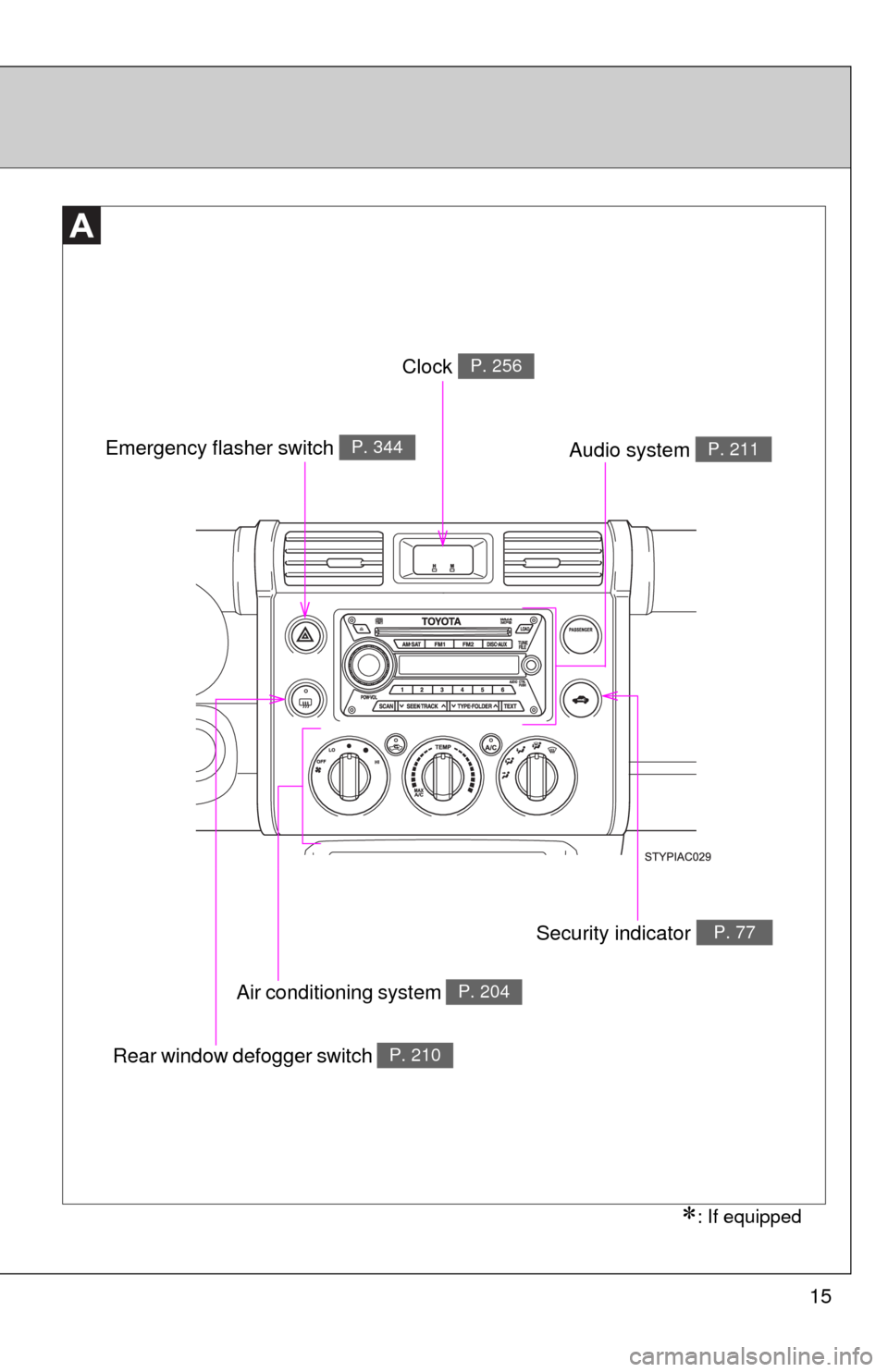
15
: If equipped
Clock P. 256
Emergency flasher switch P. 344Audio system P. 211
Security indicator P. 77
Air conditioning system P. 204
Rear window defogger switch P. 210
Page 31 of 439

31 1-2. Opening, closing and locking the doors
1
Before driving
■Key battery depletion
The standard battery life is 1 to 2 years. (The battery becomes depleted
even if the key is not used.) If the wireless remote control function does not
operate, the battery may be depleted. Replace the battery when necessary.
(P. 322)
■Security feature
If a door is not opened within approximately 60 seconds after the vehicle is
unlocked, the security feature automatically locks the vehicle again.
■Conditions affecting operation
The wireless remote control function may not operate normally in the follow-
ing situations.
●Near a TV tower, radio station, electric power plant, airport or other facil-
ity that generates strong radio waves
●When carrying a portable radio, cellular phone or other wireless commu-
nication device
●When multiple wireless keys are in the vicinity
●When the wireless key has come into contact with, or is covered by a
metallic object
●When a wireless key (that emits radio waves) is being used nearby
●When the wireless key has been left near an electrical appliance such as
a personal computer
■Customization that can be configured at Toyota dealer
Settings (e.g. wireless remote control system) can be changed.
(Customizable features P. 412)
Page 41 of 439
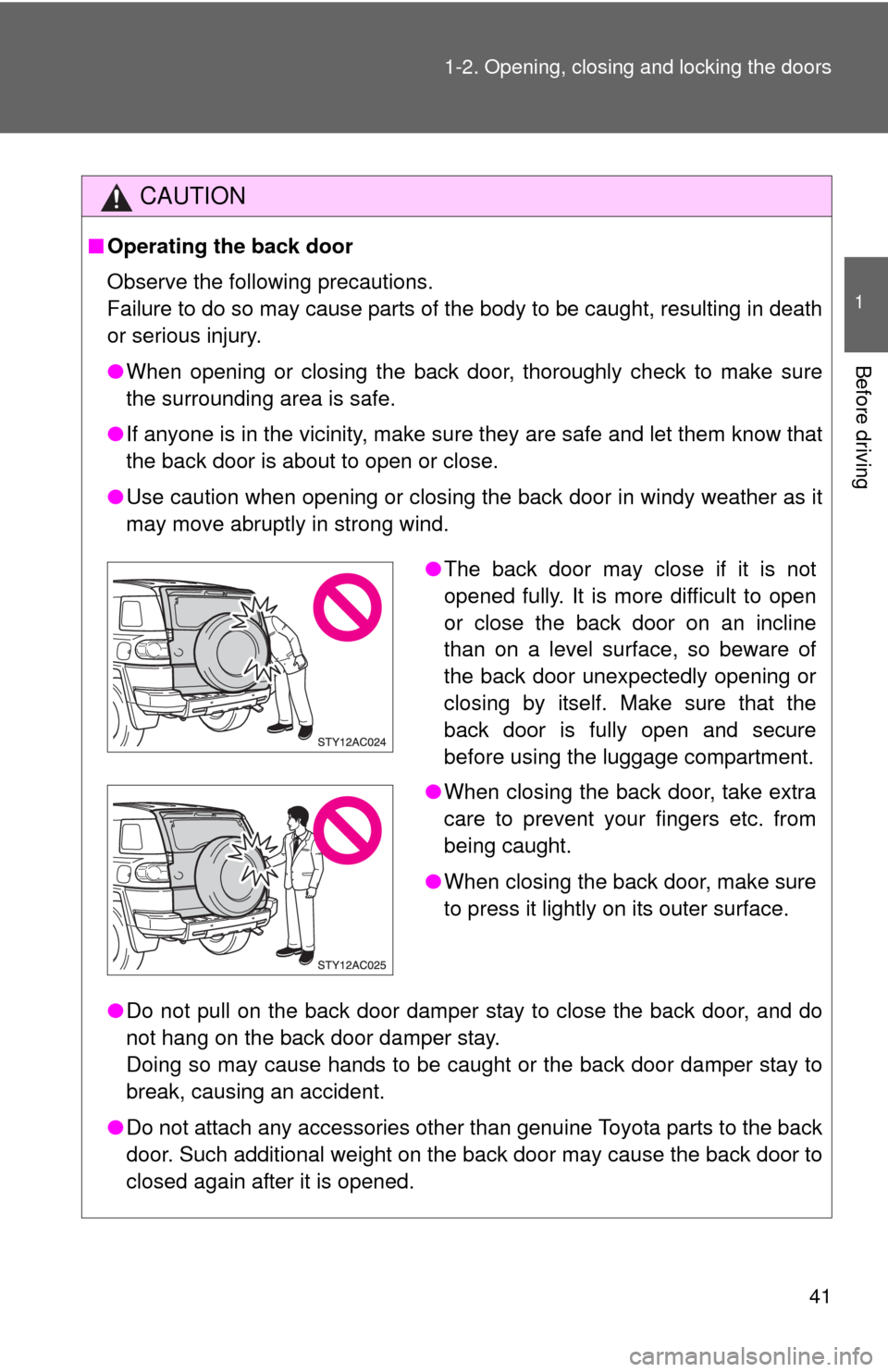
41 1-2. Opening, closing and locking the doors
1
Before driving
CAUTION
■Operating the back door
Observe the following precautions.
Failure to do so may cause parts of the body to be caught, resulting in death
or serious injury.
●When opening or closing the back door, thoroughly check to make sure
the surrounding area is safe.
●If anyone is in the vicinity, make sure they are safe and let them know that
the back door is about to open or close.
●Use caution when opening or closing the back door in windy weather as it
may move abruptly in strong wind.
●Do not pull on the back door damper stay to close the back door, and do
not hang on the back door damper stay.
Doing so may cause hands to be caught or the back door damper stay to
break, causing an accident.
●Do not attach any accessories other than genuine Toyota parts to the back
door. Such additional weight on the back door may cause the back door to
closed again after it is opened.
●The back door may close if it is not
opened fully. It is more difficult to open
or close the back door on an incline
than on a level surface, so beware of
the back door unexpectedly opening or
closing by itself. Make sure that the
back door is fully open and secure
before using the luggage compartment.
●When closing the back door, take extra
care to prevent your fingers etc. from
being caught.
●When closing the back door, make sure
to press it lightly on its outer surface.
Page 43 of 439
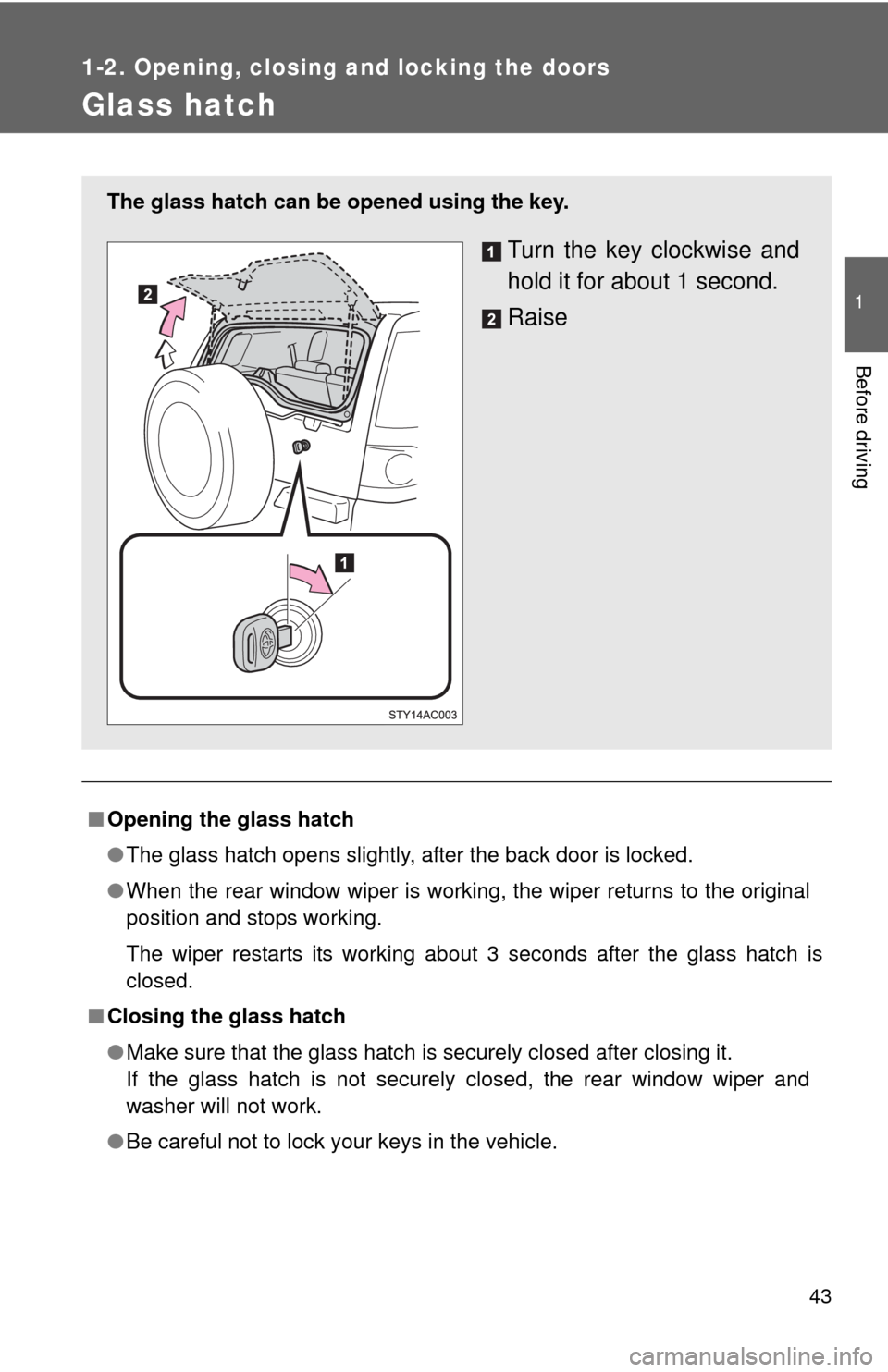
43
1
1-2. Opening, closing and locking the doors
Before driving
Glass hatch
■Opening the glass hatch
●The glass hatch opens slightly, after the back door is locked.
●When the rear window wiper is working, the wiper returns to the original
position and stops working.
The wiper restarts its working about 3 seconds after the glass hatch is
closed.
■Closing the glass hatch
●Make sure that the glass hatch is securely closed after closing it.
If the glass hatch is not securely closed, the rear window wiper and
washer will not work.
●Be careful not to lock your keys in the vehicle.
The glass hatch can be opened using the key.
Turn the key clockwise and
hold it for about 1 second.
Raise
Page 45 of 439
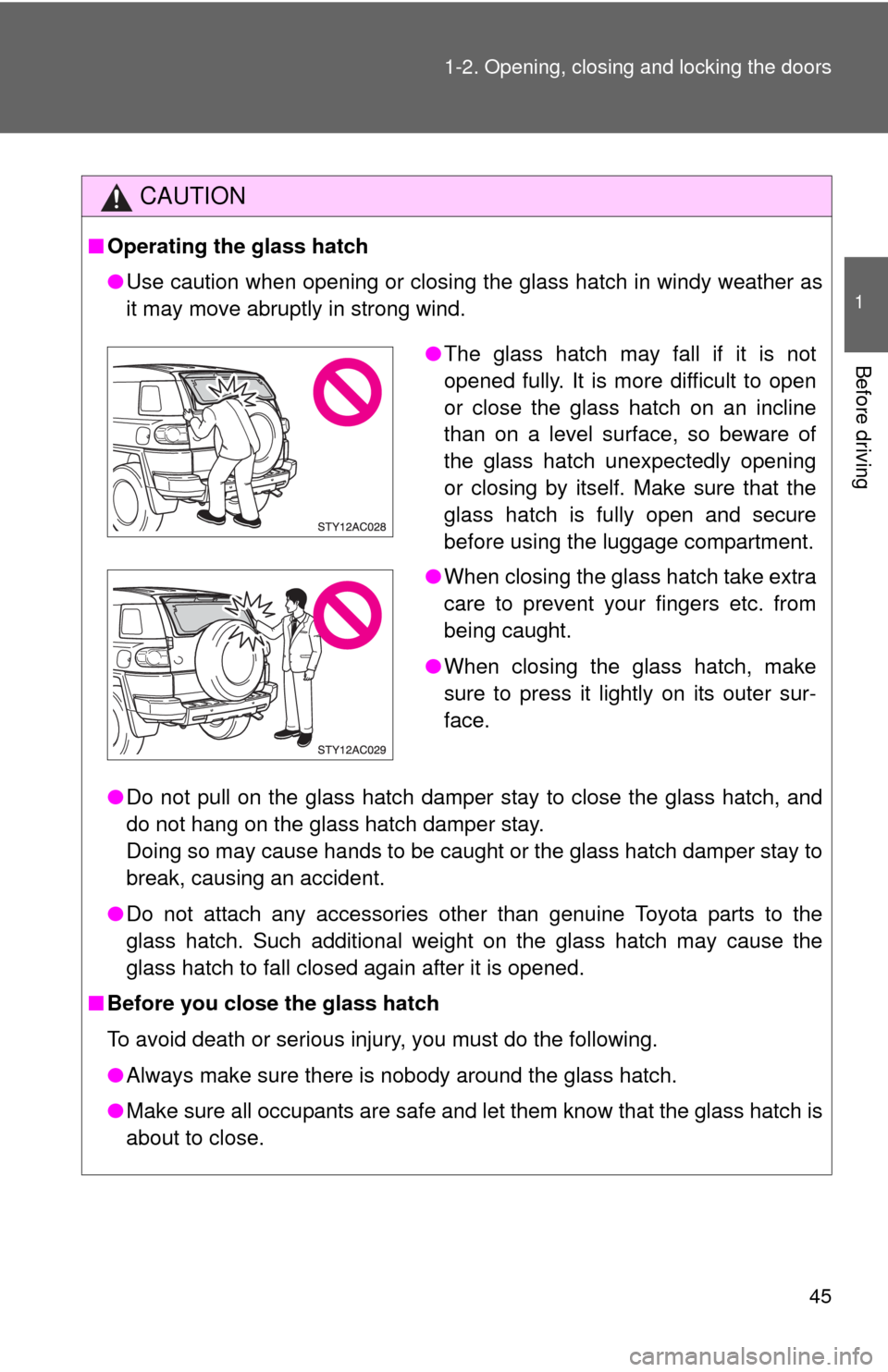
45 1-2. Opening, closing and locking the doors
1
Before driving
CAUTION
■Operating the glass hatch
●Use caution when opening or closing the glass hatch in windy weather as
it may move abruptly in strong wind.
●Do not pull on the glass hatch damper stay to close the glass hatch, and
do not hang on the glass hatch damper stay.
Doing so may cause hands to be caught or the glass hatch damper stay to
break, causing an accident.
●Do not attach any accessories other than genuine Toyota parts to the
glass hatch. Such additional weight on the glass hatch may cause the
glass hatch to fall closed again after it is opened.
■Before you close the glass hatch
To avoid death or serious injury, you must do the following.
●Always make sure there is nobody around the glass hatch.
●Make sure all occupants are safe and let them know that the glass hatch is
about to close.
●The glass hatch may fall if it is not
opened fully. It is more difficult to open
or close the glass hatch on an incline
than on a level surface, so beware of
the glass hatch unexpectedly opening
or closing by itself. Make sure that the
glass hatch is fully open and secure
before using the luggage compartment.
●When closing the glass hatch take extra
care to prevent your fingers etc. from
being caught.
●When closing the glass hatch, make
sure to press it lightly on its outer sur-
face.
Page 53 of 439
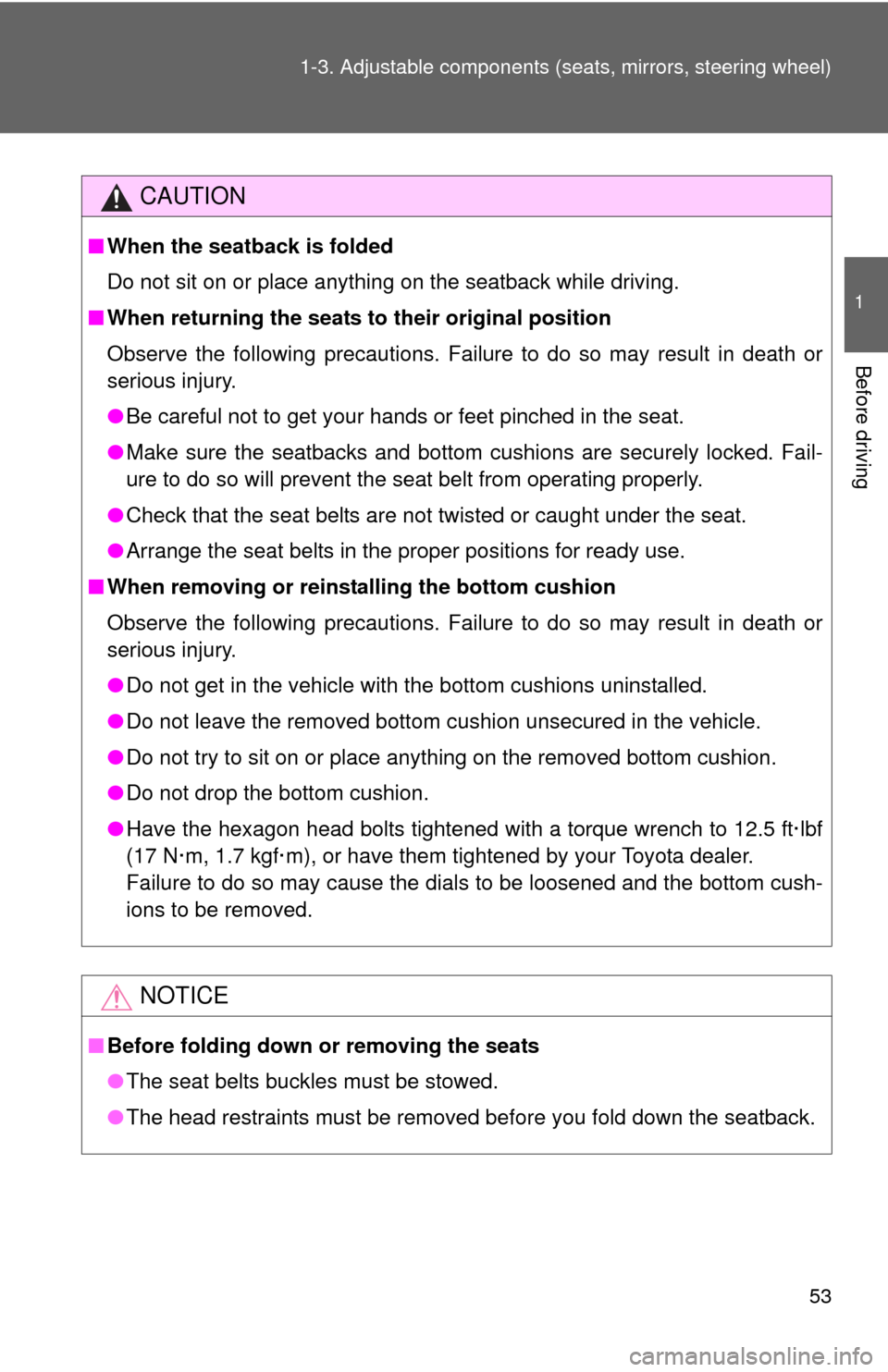
53 1-3. Adjustable components (seats, mirrors, steering wheel)
1
Before driving
CAUTION
■When the seatback is folded
Do not sit on or place anything on the seatback while driving.
■When returning the seats to their original position
Observe the following precautions. Failure to do so may result in death or
serious injury.
●Be careful not to get your hands or feet pinched in the seat.
●Make sure the seatbacks and bottom cushions are securely locked. Fail-
ure to do so will prevent the seat belt from operating properly.
●Check that the seat belts are not twisted or caught under the seat.
●Arrange the seat belts in the proper positions for ready use.
■When removing or reinstalling the bottom cushion
Observe the following precautions. Failure to do so may result in death or
serious injury.
●Do not get in the vehicle with the bottom cushions uninstalled.
●Do not leave the removed bottom cushion unsecured in the vehicle.
●Do not try to sit on or place anything on the removed bottom cushion.
●Do not drop the bottom cushion.
●Have the hexagon head bolts tightened with a torque wrench to 12.5 ft·lbf
(17 N·m, 1.7 kgf·m), or have them tightened by your Toyota dealer.
Failure to do so may cause the dials to be loosened and the bottom cush-
ions to be removed.
NOTICE
■Before folding down or removing the seats
●The seat belts buckles must be stowed.
●The head restraints must be removed before you fold down the seatback.
Page 60 of 439
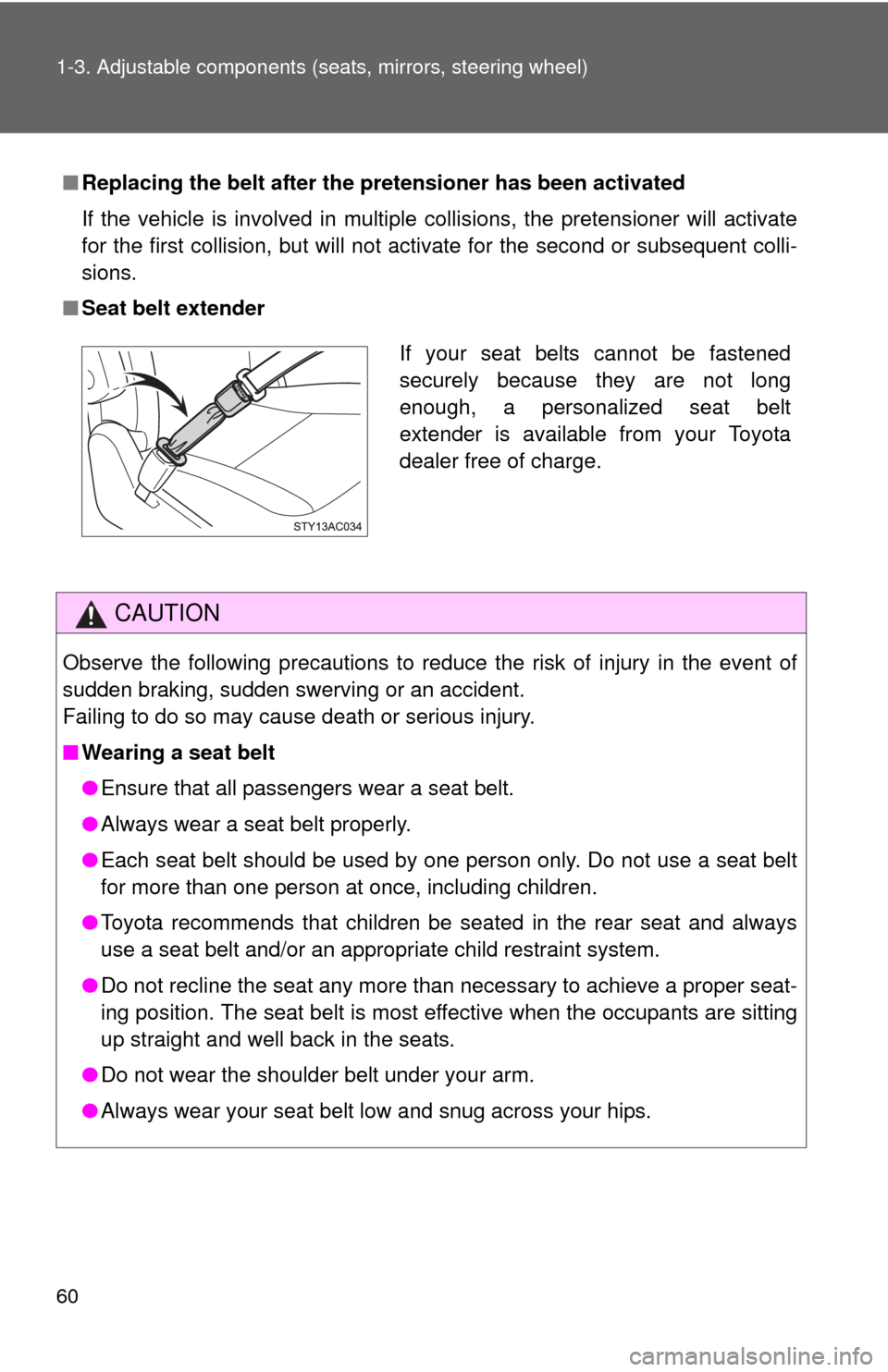
60 1-3. Adjustable components (seats, mirrors, steering wheel)
■Replacing the belt after the pretensioner has been activated
If the vehicle is involved in multiple collisions, the pretensioner will activate
for the first collision, but will not activate for the second or subsequent colli-
sions.
■Seat belt extender
CAUTION
Observe the following precautions to reduce the risk of injury in the event of
sudden braking, sudden swerving or an accident.
Failing to do so may cause death or serious injury.
■Wearing a seat belt
●Ensure that all passengers wear a seat belt.
●Always wear a seat belt properly.
●Each seat belt should be used by one person only. Do not use a seat belt
for more than one person at once, including children.
●Toyota recommends that children be seated in the rear seat and always
use a seat belt and/or an appropriate child restraint system.
●Do not recline the seat any more than necessary to achieve a proper seat-
ing position. The seat belt is most effective when the occupants are sitting
up straight and well back in the seats.
●Do not wear the shoulder belt under your arm.
●Always wear your seat belt low and snug across your hips.
If your seat belts cannot be fastened
securely because they are not long
enough, a personalized seat belt
extender is available from your Toyota
dealer free of charge.
Page 62 of 439
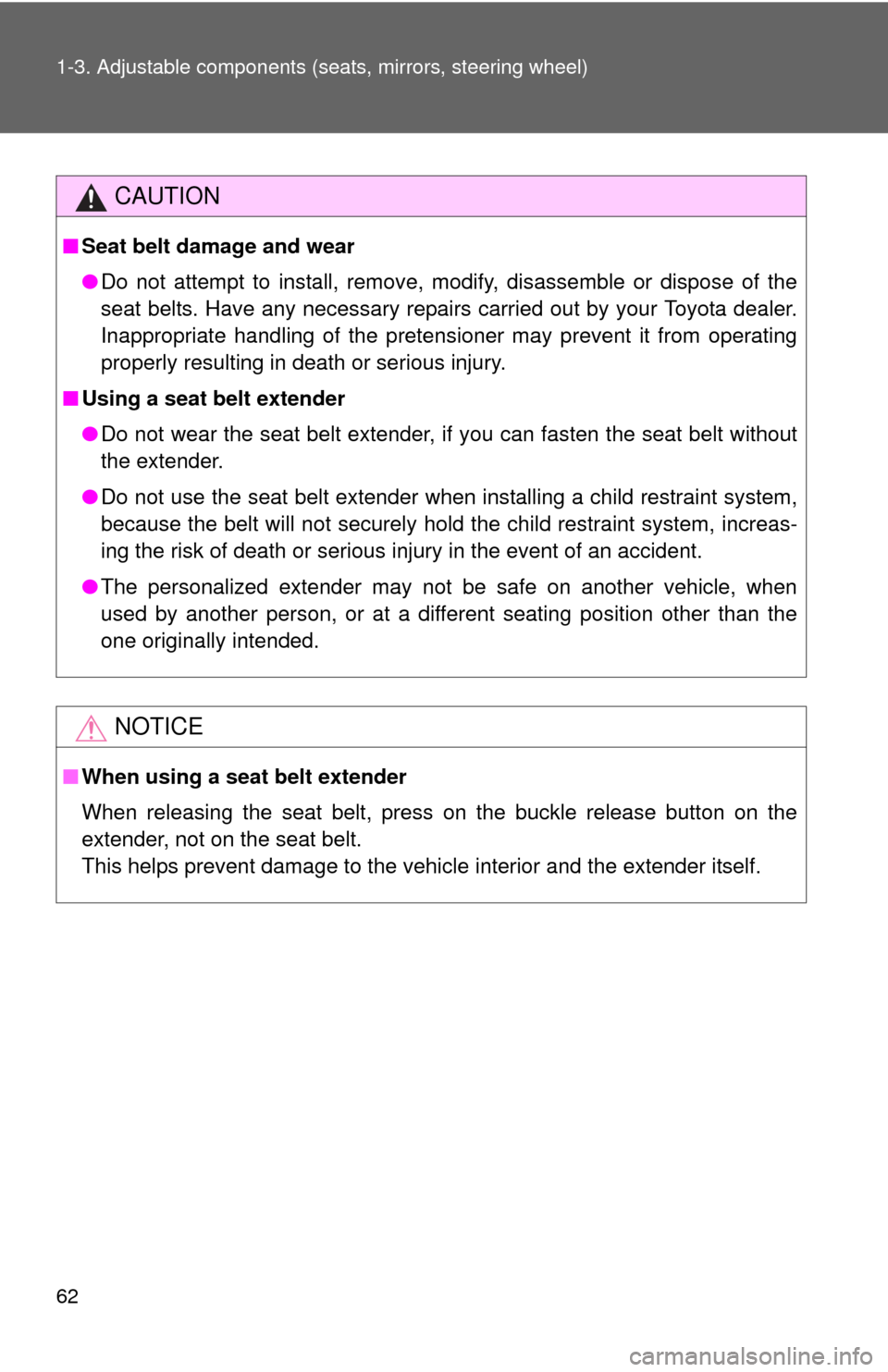
62 1-3. Adjustable components (seats, mirrors, steering wheel)
CAUTION
■Seat belt damage and wear
●Do not attempt to install, remove, modify, disassemble or dispose of the
seat belts. Have any necessary repairs carried out by your Toyota dealer.
Inappropriate handling of the pretensioner may prevent it from operating
properly resulting in death or serious injury.
■Using a seat belt extender
●Do not wear the seat belt extender, if you can fasten the seat belt without
the extender.
●Do not use the seat belt extender when installing a child restraint system,
because the belt will not securely hold the child restraint system, increas-
ing the risk of death or serious injury in the event of an accident.
●The personalized extender may not be safe on another vehicle, when
used by another person, or at a different seating position other than the
one originally intended.
NOTICE
■When using a seat belt extender
When releasing the seat belt, press on the buckle release button on the
extender, not on the seat belt.
This helps prevent damage to the vehicle interior and the extender itself.
Page 63 of 439
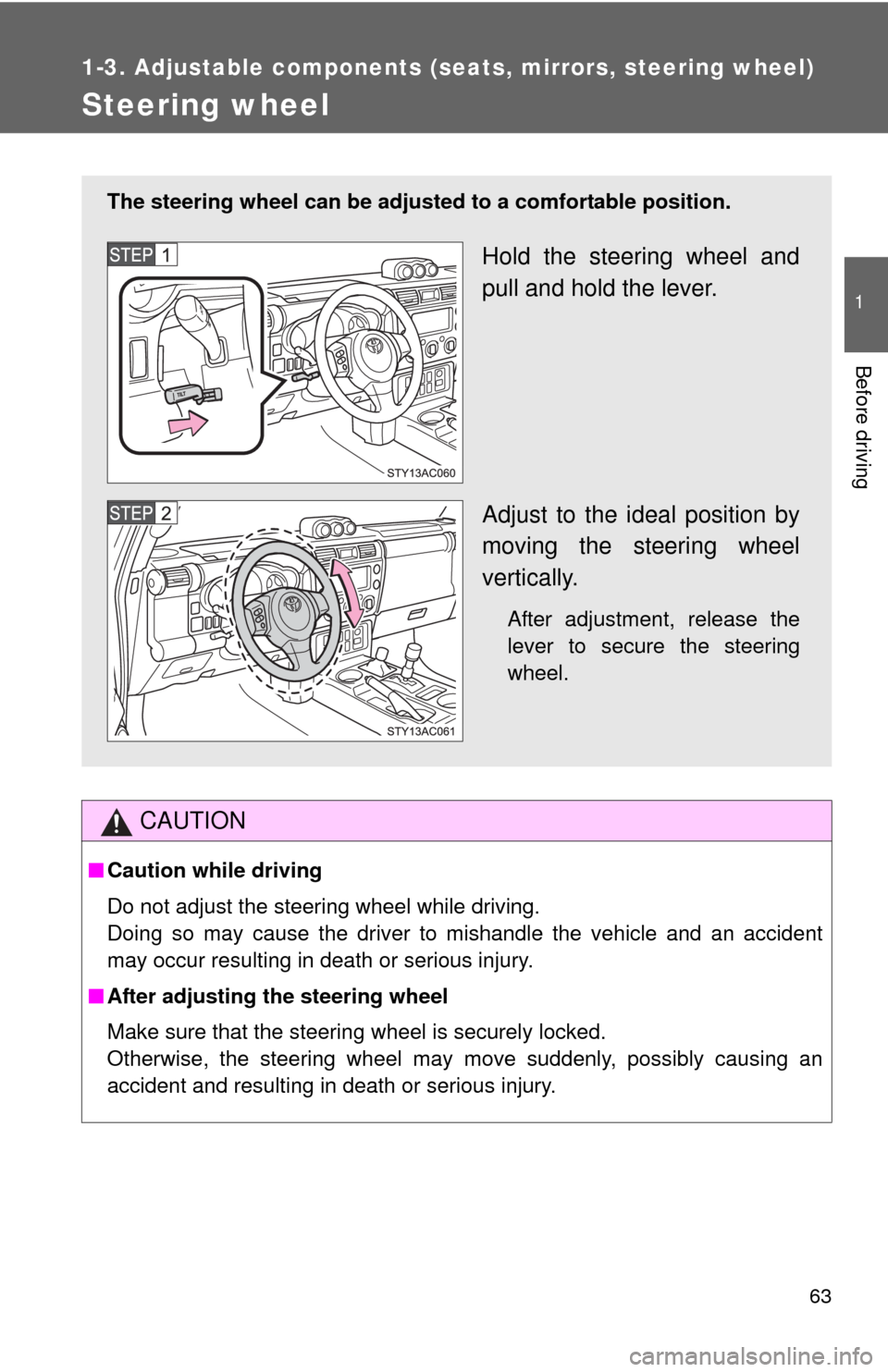
63
1
1-3. Adjustable components (seats, mirrors, steering wheel)
Before driving
Steering wheel
CAUTION
■Caution while driving
Do not adjust the steering wheel while driving.
Doing so may cause the driver to mishandle the vehicle and an accident
may occur resulting in death or serious injury.
■After adjusting the steering wheel
Make sure that the steering wheel is securely locked.
Otherwise, the steering wheel may move suddenly, possibly causing an
accident and resulting in death or serious injury.
The steering wheel can be adjusted to a comfortable position.
Hold the steering wheel and
pull and hold the lever.
Adjust to the ideal position by
moving the steering wheel
vertically.
After adjustment, release the
lever to secure the steering
wheel.
Page 77 of 439
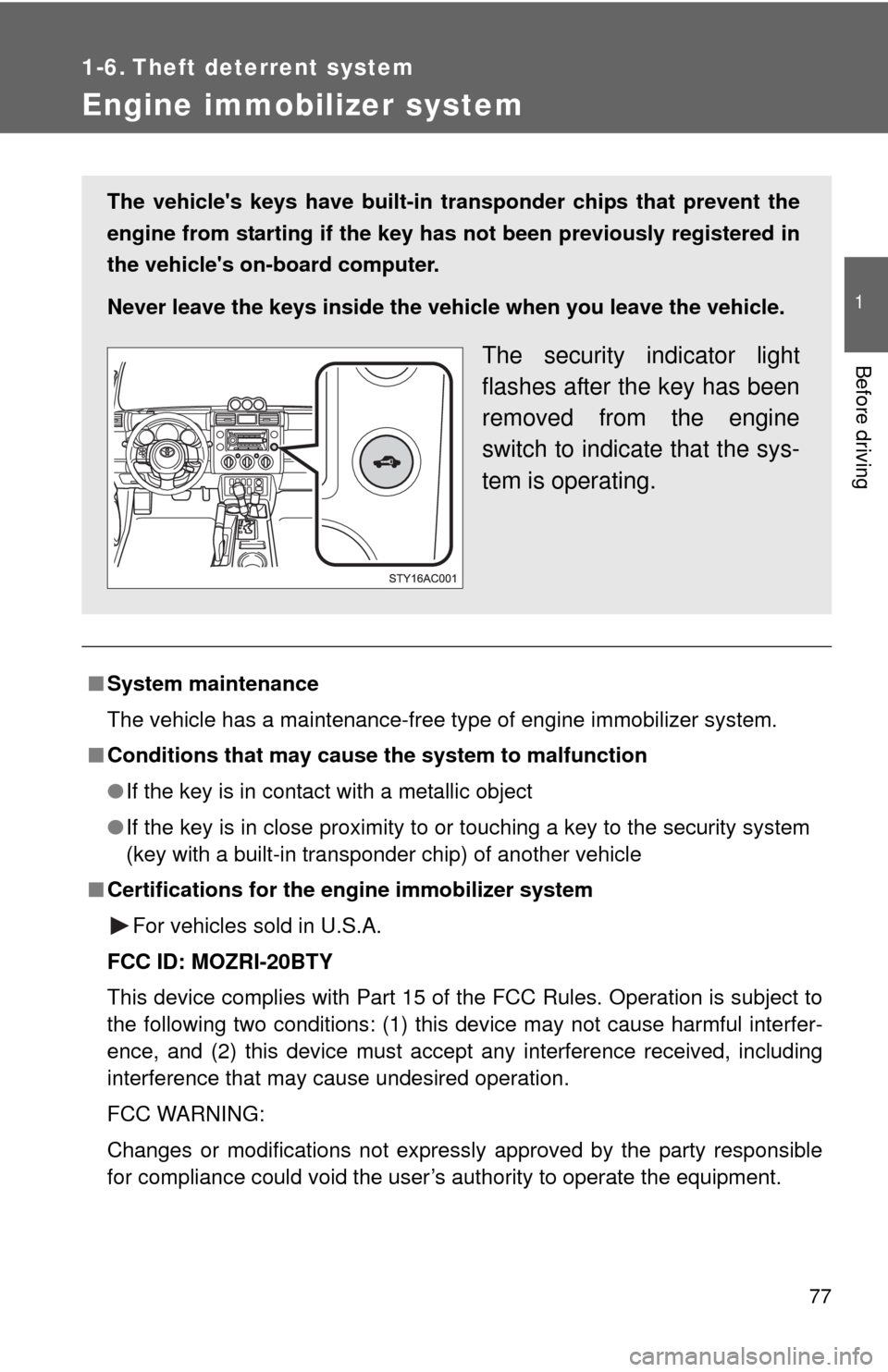
77
1
Before driving
1-6. Theft deterrent system
Engine immobilizer system
■System maintenance
The vehicle has a maintenance-free type of engine immobilizer system.
■Conditions that may cause the system to malfunction
●If the key is in contact with a metallic object
●If the key is in close proximity to or touching a key to the security system
(key with a built-in transponder chip) of another vehicle
■Certifications for the engine immobilizer system
For vehicles sold in U.S.A.
FCC ID: MOZRI-20BTY
This device complies with Part 15 of the FCC Rules. Operation is subject to
the following two conditions: (1) this device may not cause harmful interfer-
ence, and (2) this device must accept any interference received, including
interference that may cause undesired operation.
FCC WARNING:
Changes or modifications not expressly approved by the party responsible
for compliance could void the user’s authority to operate the equipment.
The vehicle's keys have built-in transponder chips that prevent the
engine from starting if the key has not been previously registered in
the vehicle's on-board computer.
Never leave the keys inside the vehicle when you leave the vehicle.
The security indicator light
flashes after the key has been
removed from the engine
switch to indicate that the sys-
tem is operating.